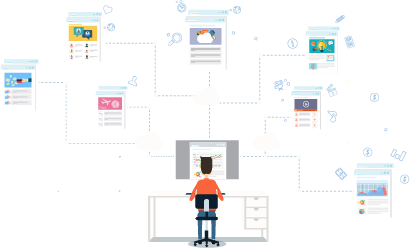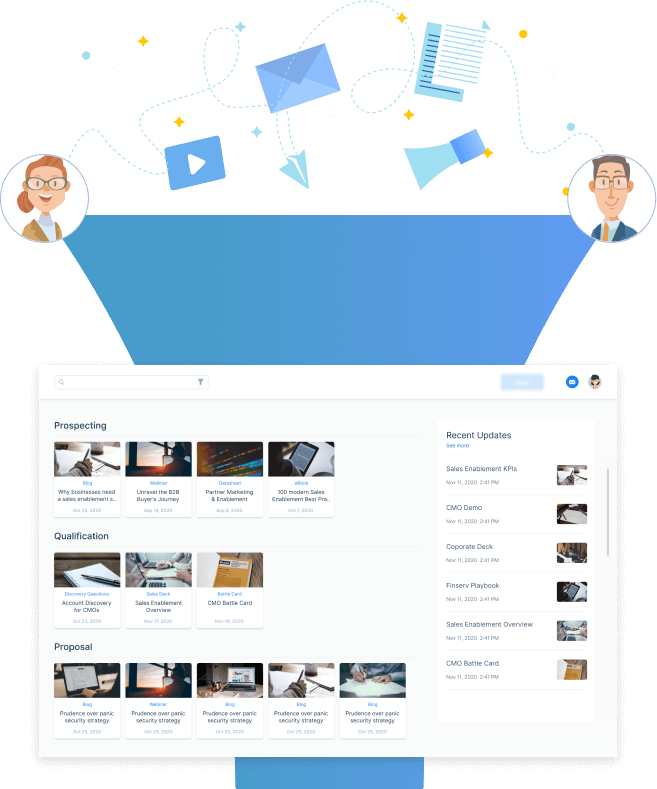Table of Contents
Does this sound familiar?
- You have a buyer that is interested in your offering but hasn’t committed.
- You have a buyer who is looking at different vendors to address a business problem. You want to make an impression that makes you stand out from the competition.
- Your buyer contact convinced but needs help to convince other stakeholders to purchase your offering.
- You have a buyer that sees value in your offering but the timing isn’t right.
- As a rep, you are convinced that the offering will help the buyer meet his job objectives. You see the fit but the buyer doesn’t.
These are quite common scenarios in the sales process. There is already so much talk about building credibility with prospects and enabling them to make a purchase and content plays a big role in helping sales reps with building this credibility.
Reps can use content effectively to help move these conversations forward and overcome these common obstacles.
Relevant and targeted content can help educate buyers so that they can make informed decisions.
In this blog post, we look at seven types of content assets that reps can use to build credibility with their buyers.
Industry Articles
Today’s businesses operate in a highly competitive environment. And every business has a position or a unique differentiation that it brings to the market.
Using an Industry Article to validate and support your company’s position in the market is a great way to build credibility with your buyers.
The obvious advantage of Industry Articles is that your company does not have to invest in writing those articles. It gives you an opportunity to piggyback on someone else’s content to emphasize your position.
Plus, content from an external, unbiased source helps with your brand’s position. Even better if the article is from an industry-reputed source.
Content plays an important role in helping reps perform the above activities. And content comes in many forms and types to support these important activities. Here are some specific content examples that are used for an event.
This is a great way to help a buyer build a business case internally when they look to support.
We have a great example to share from our own experience at Enablix. We always talk about the benefits of sound content management practices for marketing and with the availability of free tools like Google Drive and Sharepoint, marketers (our product’s buyers) need to be convinced of the benefits of a paid solution over the free ones.
We know that marketers could benefit immensely by employing the right process and technology for managing content rather than use generic free tools that do not help with enablement. A 2019 article from Content Marketing Institute (CMI) discusses this pain and aligns with our messaging.
For our team, this article is a great asset for prospecting. It does an excellent job of discussing:
- The importance of scaling content
- A need for content strategy
- How poorly organizations are performing when it comes to scaling content
The above points do a solid job of supporting our position that marketers should revisit their content management strategy. And our buyers are more likely to trust an opinion from a reputed source as CMI than us.
Success Stories & Case Studies
We all know success stories and customer case studies are very useful when prospecting to build credibility. Increasingly, companies are putting more and more of these stories on their website to help visitors find through search engines as well as build a brand. And without a doubt, you are using case studies to help with your outreach and nurturing cadence.
Here are some best practices when engaging with your buyers with case studies and customer success stories:
- Don’t Assume Buyers Know – Just because case studies are publicly available on your website, don’t assume that your buyers already know about them. And even if data shows that they have accessed the case study, it doesn’t hurt to refresh their memory.
- Target Case Studies To Buyer’s Needs – If you have several case studies to work with, make sure you target case studies that closely align with your buyer’s needs. If there are multiple case studies that cover your buyer’s needs, then share multiple ones. It should be about your buyer’s need and not about your customer’s success when sharing these case studies.
- Context Is Important – When sharing these case studies, please provide the right context.
- Don’t make your buyer pull information out of the case study. Instead, guide the buyer to the right information in a success story.
- Use Email To Your Advantage – It is quite likely that you are sharing this case study via email. Email offers you an opportunity to drive personalization and targeting. We discussed in an earlier point that a rep has to help the buyer with the value points in the case study. And email offers the best medium to spell out those value points. Use your knowledge about the buyer and their pain points to craft the right message in your email.
We recently released a 90-day report card for one of our customers who went live with Enablix. This 90-day report card presented a snapshot of the customer’s usage of the content and the successes they have experienced. And this one customer story is relevant for different buyers and prospects.
- Prospects who have similar-sized sales and marketing organization
- Prospects who have a similar sales and marketing technology stack as this customer
- Prospects who have shown us a keen interest in having visibility into internal (sales) and external (their prospects) content adoption.
The above context is very important when sharing assets with the buyer. And we can build this context right in our email to provide value. The purpose of the case study is to support your copy in the email that you send to your buyer.
Blog Posts
Blogs are a staple content for many companies. They are a great tool for companies to build a web presence and drive inbound traffic. They also help communicate with your website visitors what you are all about.
But, the usefulness of Blogs should not be limited to building awareness and generating inbound leads. Blogs can be a great asset for sales reps to further their conversations with their buyers. Reps know buyers better than anyone else.
Through discovery calls, meetings, demo presentations, and other interactions, they know their buyer’s pain points and priorities. And your conversations with them will be highly effective when you communicate with your buyers in the context of those priorities.
Blogs tend to be topical and focused and are a great asset for a rep to help them with their contextual conversations. Here are some generic scenarios that are great examples of how blogs tend to be useful to build credibility with your prospects.
- Your buyer is interested in the integration of your offering with an incumbent third-party application. Your product team has a blog post that discusses their take on this particular third-party application and discusses your integration. Sharing this post with your prospect tells them that you have it covered and your product team has already thought about it. And even better if your prospect learns something new about this application from the blog post.
- Your product uses artificial intelligence (AI) to solve certain business problems. The CIO of your prospect is interested in the nitty-gritty details of this AI capability. You can share multiple blog posts on this AI topic with the CIO to help him see what is under the hood and start a dialog.
- Newmarket development is making rounds in your target industry. And this development has an impact on how buyers are going to benefit from your offering. You can do yourself a huge favor by establishing credibility with your buyers as experts in this new market development. They are hungry for more details and providing those insights will establish your brand as a trusted advisor in your buyer’s mind.
There are countless such examples where blog posts can be highly effective in building rapport with the prospect. Similar to case studies and success stories, it is important that you share these blog posts with the right context and not let the buyer hunt down the relevant information from a blog post.
At Enablix, our marketing users love the control they can exercise on the content assets when sharing with sales.
During demos and conversations, content access is always discussed. Buyers want to know how they can control access to different content assets to make sure sensitive information is not shared externally by customer-facing team members. And we have written a blog post about this topic.
Important Slides
Most of us are not fans of presentations. Your prospects are no exception. Sharing a 20 slide deck with your prospect is rarely going to make a positive impression on your prospect. You are asking them to sift through a ton of information.
The bottom line, it is boring and unimpressive. However, you will realize that there is a ton of amazing content in these presentations. It is just in a poor structure lumped together with a lot of other content that may not be relevant to your buyers.
Even today, when we built our introductory product deck, we have some of our best content and creativity going into building specific presentation slides.
We believe that here lies an untapped opportunity for reps to leverage this content to their benefit. Sharing one or two slides that speak to a topic (that your prospects deeply cares about) is a great way to build credible interactions. Examples,
- A component diagram showing a typical business process ecosystem and highlighting where your offering fits in the puzzle. This one slide can clearly articulate how you help your prospects and where you fit in their process.
- A feature slide that provides details on a particular feature that your buyer deems important for their success.
- Team composition diagram that shows what roles are involved in servicing the project. Again an important slide for your buyer as it tells them how your team will be structured if they select your offering to meet their requirements.
The list is endless.
However, expecting sales reps to pull these stellar slides out of your giant slide decks is expecting too much of them. Instead do them a favor, and break these slides into relevant slides and store them in a slide library.
Your reps will find it easy to find these slides and share them with prospects.
At Enablix, we care about a personalized experience for our application users. Our primary application users are sales reps. And to support a personalized experience, we employ Bayesian Networks that help rank content assets for every user.
This ranking is done by taking into account different factors and parameters. For buyers who care about a personalized experience, we share this slide which shows them the list of factors that influence the personalization score.
Analyst Research and Reports
Using Analyst Research and Reports for sales conversations is a no-brainer. These research and report assets are similar to Industry Articles but are likely to be more relevant and score high on the credibility meter for your buyers. Some examples:
- Industry research reports by analysts are high-value assets. Especially when the narrative of the report aligns with your company’s differentiators in the marketplace. It is useful to have a third-party opine on a particular topic or share research data that validates your messaging.
- Analyst vendor reports for your target market are also quite useful. Especially, if the report is favorable to your company’s offering.
- Today, there are several review company’s that are propping up and using favorable news from these review sites can be helpful to support your buyer interactions.
If your contacts at your prospect accounts are rooting for your offering, they have to convince others in their company before they can commit to the business transaction. Analyst research and reports help these buyers drive consensus amongst different individuals in your favor.
At Enablix, we have our users share their experiences on G2 Crowd. Plus G2 Crowd has given us points by naming us the High Performer in the Sales Enablement category for 2019. This recognition by a third party helps us in our deals when we engage with buyers who are considering a broad set of choices to meet their sales content enablement needs.
Frequently Asked Questions
FAQs are popular content assets and have been used for a long time to help sellers prepare to answer buyer questions. However, FAQs can also be used to build credibility with your buyers. It is likely that your buyer has never purchased this solution or even if they have purchased a similar solution before, the context of that purchase was different.
On the other hand, you have delivered your solution to several customers and made them successful. You have visibility into the various challenges that customers could run into when addressing the business problem. You can leverage this knowledge and fairly accurately target prospects that are likely to face these challenges.
Preemptively sharing these challenges and their solutions in an FAQ format can be very useful to your buyer. It can help them get past internal objections, paint a clearer picture of the expected outcomes, and set the right expectations with their own management and leadership.
Here are some categories of FAQs that are useful in building credibility and standing out of the crowd.
Pricing FAQs
Pricing is an important aspect for your buyer and the buying organization. Your buyer contact (or champion) has to internally sell your offering’s pricing to the finance and leadership team.
So having a series of FAQs prepared for Pricing and targeting these FAQs for your buyer’s context can be highly valuable to your buyer and to your chances of winning business. Some of the pricing topics that are every-popular are,
- Pricing for Future Growth
- Services & SetUp Pricing
- Is there a dependency on external resources (third-party integrators or consultants) to get the job done?
Integration FAQs
Your offering has to play alongside your buyer’s internal information technology landscape. Your buyer has already invested in different applications and infrastructure. And your company’s offering has to co-exist in that environment.
When you know your buyer’s tech landscape, it will help them to understand how your offering fits into their tech and application landscape.
Timeline FAQs
A buyer is purchasing your tool or service to address a business problem. And they want to know WHEN they can expect the results.
If you can give visibility into the expected timeline (given their context and their requirements), they can use that information to set the right expectations with their stakeholders.
A properly managed FAQ library is very useful to have high-quality conversations with your buyer. Arming reps with these FAQs will give them an opportunity to help their buyers and in turn help speed up the selling process.
Customer Success Insights
Details are important. The high-level ten-thousand feet level information is already available on the internet. And it is quite likely that this high-level information is not that different from what your competitors are saying.
This is where insights from your customer’s success are useful. Your buyer is likely to experience the same challenges that your customers have experienced or are experiencing with their projects and objectives.
Learnings from your customers are a gold mine for making an impression with your prospects.
Customer Success Insights are not Case Studies. They are deeper and focused insights that your customers experience as they use your product or service.
It could be that it has nothing to do with your product but relevant to the problem space in which your product exists. Collect these insights and share these insights with your prospects and you will see the relationship change for the positive.
Gartner, in its 2018 study Win More B2B Sales Deals, talks about the important role of Information in the buying process. And how reps can help connect buyers with the right information and significantly increase their chances of success.
Gartner coined the term “buyer enablement” to describe the provisioning of information to customers in a way that enables them to complete critical buying jobs.
In the same Gartner report, the authors discuss the two categories of information relating to buyer enablement.
- Prescriptive Advice – The What: Help us know what to do.
- Practical Support – The How: Help us complete discrete, job-related activities
- Customer Success Insights serve these two categories of information very well.
The other advantages of customer insights are:
Unique To Your Company
Customer Success Insights tend to be very specific and detailed. And therefore they are quite likely to be unique to your company. For instance, we share quarterly content reports with our customers. Over several months, we have built on this library of reports based on our customer feedback and our own study of our customers.
Our customers love these reports and have shared with us how these reports have helped them keep their peer stakeholders from other groups on the same page when it comes to content.
These reports and the feedback on these reports present a great opportunity for us to build a targeted insight that we can share with our prospects and buyers.
Sharing these reports helps the buyer recognize how Enablix can help them better align with other stakeholders when it comes to content and sales enablement.
Arm your buyer with information to build consensus
Your primary buyer’s important job is to build consensus among his colleagues to purchase a solution, preferably your solution.
Customer Success Insights arm your buyers with detailed information that can help them build that consensus within their organization. At Enablix, it is very common for our buyer’s IT partner to be involved in the purchase process. Having worked with several customers and addressed several queries for their IT department.
We have built some detailed assets that address common IT-related queries from our buyer’s IT department.
Many times, we do not even wait for our buyers to ask for this information. We pro-actively share this information. This tells our buyers that we are already thinking two steps ahead for helping them succeed.
Help targeted enablement
Every buyer is unique. And buyers are always concerned about being the first to try out any solution. Therefore, it helps if the buyer knows that their environment and requirements are not new to you. That your organization has successfully addressed these needs with other customers.
Customer Success Insights can really help drive that targeted dialog with their buyer that speaks to their requirements and their internal environment. At Enablix, we have customers on GSuite and Office 365. And our prospects are always concerned about how our platform can seamlessly integrate with their office applications.
We have curated targeted insights from our deployments with GSuite and Officer 365 to help address our buyer’s concerns.
Your customer success team is a great source for gathering and creating valuable Customer Success Insights. They are in the trenches with your customers and are intimately familiar with every challenge that your customers faced and overcame during the course of their relationship with your product.
As long as sales reps exist, content enablement will be important. And it is natural for us enablers to focus on content that helps reps move their opportunities forward and close deals.
However, limiting the scope of your enable efforts to opportunity-specific content is short-sighted and bound to compromise your enablement objectives in the long term. Reps need content outside the context of an opportunity. And those needs cannot be ignored.





